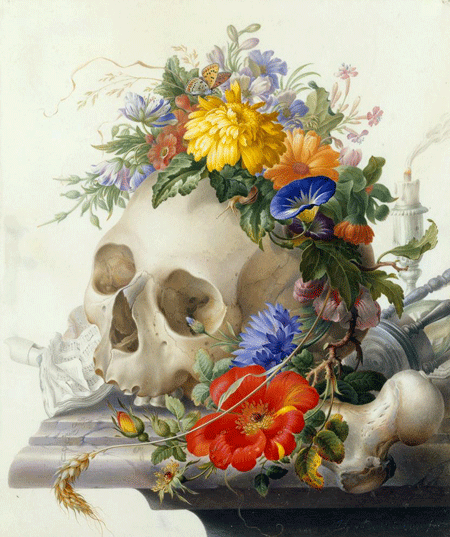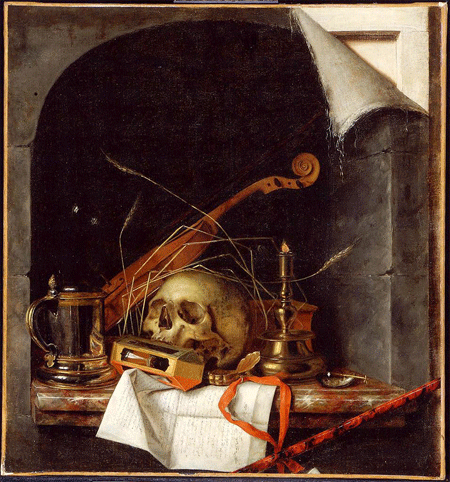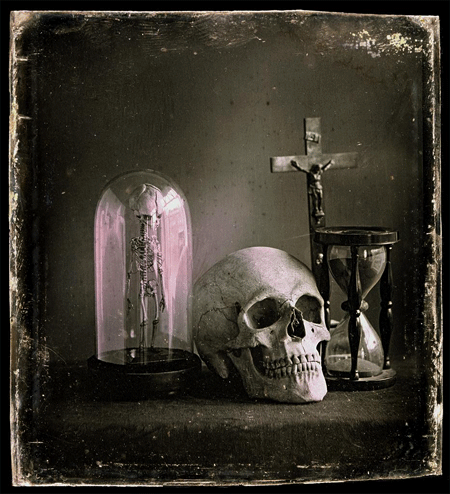It’s October, which gives us a great excuse to feature a spooky post featuring skulls! Specifically, their appearance in the still lifes known as Vanitas.

Vanitas depict objects that remind us of our mortality and the transience of earthly pleasures. Popular in the sixteenth and seventeenth centuries, particularly in Northern Europe and the Netherlands, the genre continues to inspire artists to the present day – the Artstor Digital Library includes four terrific examples of Andy Warhol’s Skulls from the Baltimore Museum of Art, and you’ve most likely heard of Damien Hirst’s “For the love of God,” a diamond-encrusted platinum skull reputed to be the world’s most expensive art piece.
Let’s start off with the uncharacteristically bright example above, a colorful gouache by Herman Henstenburgh of a skull ironically garlanded with flowers. Aside from its unexpected prettiness, this piece from the Metropolitan Museum of Art is a great specimen because it includes many of the genre’s most common attributes: flowers, music sheets, a butterfly, a dying candle, and an hourglass, all reminders of the brevity and ephemerality of life.

We’ve also included two very different trompe l’oeil still lifes. The one above is a stunningly convincing diptych by Flemish painter Jan Gossaert of a skull and a coat of arms, painted on the back of a portrait of Jean Carondelet and of the Virgin and Child. According to the venerable art historian Horst W. Janson (of art survey fame), the concept of a reminder of death in the reverse of portraits was introduced in sepulchral sculpture in the early 15th century and was widely adopted for painted portraits throughout Northern Europe by the end of the century. Gossaert’s painting is in the Louvre, and comes to us courtesy of the Réunion des Musées Nationaux. (Tip: search for carondelet to see both sides.) The one below is by the impressively-named Cornelis Norbertus Gijsbrechts, a fellow Flemish artist who specialized in trompe l’oeil and still lifes. In this piece, Gijsbrechts wittily accentuates the theme of fleetingness by showing the painting tearing off its stretcher bars. This image is courtesy of the Museum of Fine Arts, Boston.


We close with two pieces from the 19th century: Paul Cézanne’s surprisingly painterly “Skull and Candlestick,” courtesy of the Erich Lessing Culture and Fine Arts Archives. Cézanne would return to the skull motif several times; a search for cezanne skull* will yield further examples in oil and watercolor from the Detroit Institute of Arts, the Barnes Foundation, and more. The other is a haunting daguerreotype by Louis Jules Duboscq that pairs an adult skull with the skeleton of what appears to be an infant, along with an hourglass and a crucifix. This image comes from George Eastman Museum, which also has notable skull photographs from artists such as Luis Soler Pujol and William M. Vander Weyde.

Want more? Try searching the Artstor Digital Library for vanitas, memento mori, and skull* (the asterisk will yield both singular and plural results, as we saw in this post).
You may also be interested in:


